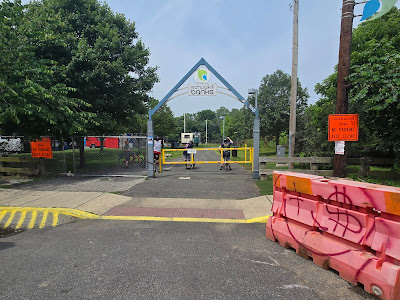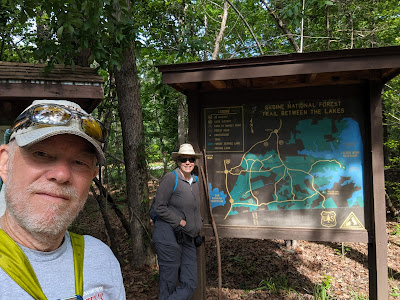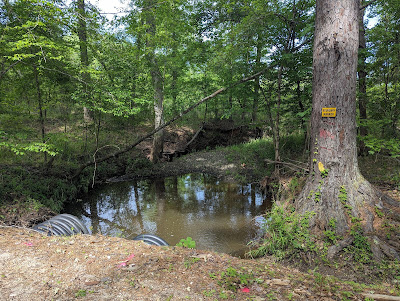Wow, it's been over a year since we moved into 20 Summers. It's taken a full year to get settled in and start to look around for our usual types of adventures. But we made it.
On June 13, 2025, we decided to take advantage of the May announcement that the Schuylkill River Trail had opened its Christian-to-Crescent Bridge, linking parts of the Schuylkill Banks section of the trail and allowing walkers, runners and cyclists to travel all the way down to Bartram Gardens. This allowed us to plan a 12-mile round trip ride from Bartram Gardens, up to the Cosmic Cafe at Boathouse Row alongside the Schuylkill River just above the Philadelphia Art Museum!
We started at Bartram Gardens, and found this view of Sankofa Community Garden for our start-of-adventure selfy:
The start of our bike ride took us past an access to the Schuylkill River allowing us a view upstream, toward a railroad bridge, in the direction of our ride:
Bartram's Gardens is a beautiful but little known attraction in South Philadelphia. It is a 50-acre public garden and National Historic Landmark, situated on the banks of the Schuylkill. Founded in 1728 by botanist John Bartram (1699–1777), it is the oldest botanical garden to survive in North America. The Garden is operated by the non-profit John Bartram Association in coordination with Philadelphia Parks and Recreation. Bartram's Garden has the only recreational access to the Schuylkill River and its wetlands. Its trails make up segments of the East Coast Greenway. The garden acts as an outdoor classroom for learning about the plants and history of Southwest Philadelphia. The John Bowman Bartram Special Collections Library contains an extensive collection of documents and materials related to the history of the Garden, the history of Philadelphia, and the development of the field of botany. The garden also serves as a venue for art.
Unfortunately, a 1.55 mile section of the Schuylkill River Trail through Bartram Gardens, known as the Bartram's Mile Trail, is closed for remediation of pollution along that stretch, but it is expected to re-open soon, which will avoid a detour we made through the city streets of Philadelphia's Kingsessing neighborhood.
Eventually, we made it across Gray's Ferry Bridge and down into the Grays Ferry neighborhood, where, with directions we received from other bicyclists, we found the southern terminus of the Schuylkill Banks section of the Schuylkill River Trail. Work is still being done on the entrance, as you can see in the photo below:
The trail seems to be fostering urban renewal in the Gray Ferry neighborhood, which is becoming an attractive and interesting home for young people. Along our route, we spotted this new fishing pier, well occupied with young, optimistic fisher people:
Looking back from where we came, we could see still-common structures from Philadelphia's industrial past --
-- but, looking head, we caught glimpses of the Schuylkill waterfront in Philadelphia's future:
By the time the trail enters Center City proper, it becomes very park-like and inviting. The numbers of walkers, runners and cyclists increased accordingly. However, the trail was wide and never felt crowded:
The skyline loomed larger as we approached across a causeway that has been in place since we left Philadelphia in 2012:
We passed the Schuylkill Banks Center, which displays information about the Delaware River watershed and also promotes kayak and riverboat tours to help visitors learn more about the Schuylkill River:
Our bike ride along the trail through Center City was a trip down memory lane, reminding us of those many bike trips we did to our office in Center City on Wednesdays, through Germantown from Cedarbrook, down the Wissahickon, and along the Schuylkill's Fairmount Park, then home again with a stop in Chestnut Hill for pizza and beer before finishing our workday round trip by bicycle.
This view of Boathouse Row and the Fairmount Dam is very familiar from those rides some 15 years ago:
The Fairmount Water Works was Philadelphia's second municipal waterworks. Designed in 1812 by Frederick Graff and originally finished in 1815, it operated until 1909, winning praise for its design and becoming a popular tourist attraction. It now houses a restaurant and an interpretive center that explains the waterworks' purpose and local watershed history. It was designated a National Historic Landmark in 1976 for its architecture and its engineering innovations. It was the nation's first water supply to use paddle wheels to move water. The main building still stands and is impressive:
We were almost to our turnaround destination, but first we passed the Fountain of the Sea Horses. This Italian travertine marble fountain featuring four sea horses was a gift from the Italian government to mark the United States’ 1926 Sesquicentennial. Fountain of the Sea Horses is a copy carved after the famed fountain at the Villa Borghese Gardens in Rome, Italy, designed by painter Christopher Unterberger and carved by sculptor Vincenzo Pacetti. The fountain, sent from Italy in 76 pieces, arrived too late for installation at the Sesquicentennial Exposition, which was held in FDR Park in South Philadelphia. It was assembled by Italian craftsmen in 1928 and installed on the axis behind the Philadelphia Museum of Art.
And then we got to Cosmic Cafe, found a table, ordered our favorite beers for hydration, and got a scrumptious vegetarian lunch!
After a hot, humid, 80F bike ride, it was wonderful to rest and cool down before heading back.
Eventually, we had to mount up and pedal back south along the river. Six miles later, as we returned to our trailhead in Bartram's Gardens, we stopped at the John Bartram house.
John Bartram was an American botanist, horticulturist, and explorer, based in Philadelphia for most of his career. Swedish botanist and taxonomist Carl Linnaeus said he was the "greatest natural botanist in the world." Bartram corresponded with and shared North American plants and seeds with a variety of scientists in England and Europe.
He founded the garden on his farm in Kingsessing, west of the Schuylkill River and miles outside and south of the what were then the borders of Philadelphia. He built its stone house between 1728 and 1731, added a kitchen around 1740, and installed a Palladian-inspired, carved facade between 1758 and 1770. The house still stands, as does his original garden (circa 1728) and greenhouse (1760). Three generations of the Bartram family continued the garden as the premier collection of North American plant species in the world. They sold it in 1850.
Bartram began building this stone house shortly after he purchased the land in 1728. Working in stages over 40 years, he incorporated elements he read about from classical Italian villas, such as carved Ionic columns and Baroque window surrounds. The stone is local bedrock, called Wissahickon schist, that was hand-quarried by Bartram and his family.
What a discovery this bike ride was! Not only have we found a bike route that we can extend another mile or two down to Gibson Point on the Schuylkill River, and extend north as far as we can ride along the Schuylkill, but we discovered the amazing history and attractions of Bartram's Gardens. We guarantee to you that there will be more about all of this in the future!























































